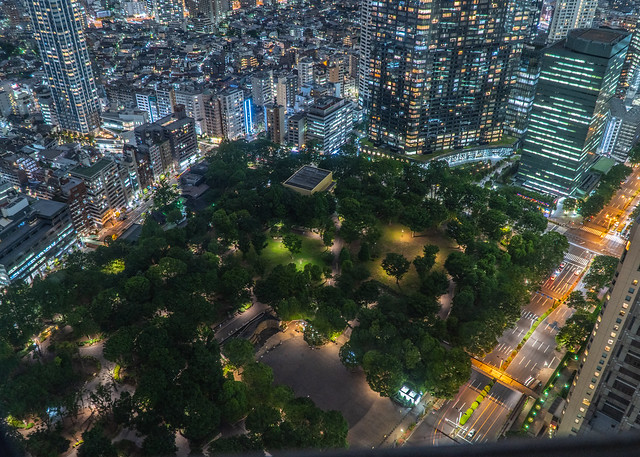Shinjuku is one of the 23 city wards of Tokyo and a major entertainment, business, and shopping hub based in Shinjuku Station.
Shinjuku Station
Shinjuku station is ranked as one of the world’s busiest railway stations, servicing more than two million passengers each day. Shinjuku Station is a massive transport hub interlinking downtown Tokyo while connecting the western suburbs and beyond.
It has around 36 platforms and 200+ exits spread across multiple buildings and underground tunnels, averaging around 15-20 minutes to walk through between each passage.
The station is serviced by subway lines such as the JR Yamanote Line, Chuo Line, Sobu Line, Saikyo Line, Shonan-Shinjuku Line, and other multiple subway operators.
It’s also a large hub for long-distance highway buses, and Busta Shinjuku located right over the railway station is conveniently handy for direct journeys to most cities and airports.
Major Districts
Shinjuku Skyscraper District
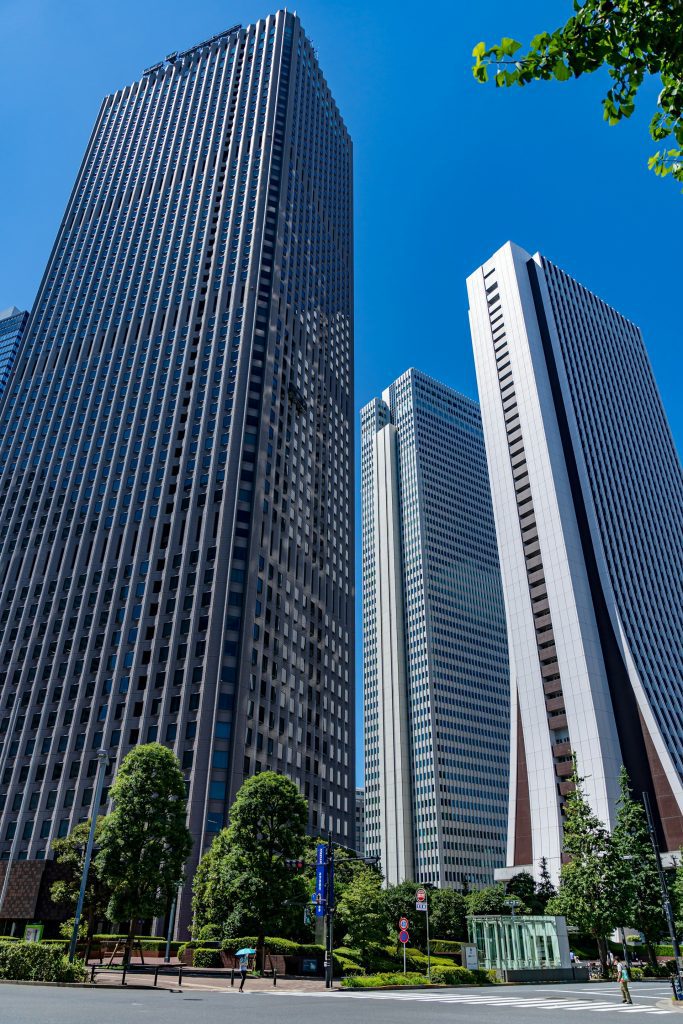
West of the station is Tokyo’s skyline, such as the Tokyo Metropolitan Government Building and luxury hotels like the Keio Plaza, Hilton Tokyo, Hyatt Regency Tokyo, and Park Hyatt Tokyo (location in the film “Lost in Translation”).
Restaurants here are open from 11:00 to 22:00, although some restaurants close during lunch and dinner. The area is currently undergoing redevelopment, with plans for a new 260-meter tall skyscraper station building scheduled for completion around 2029-2030.
Kabukicho
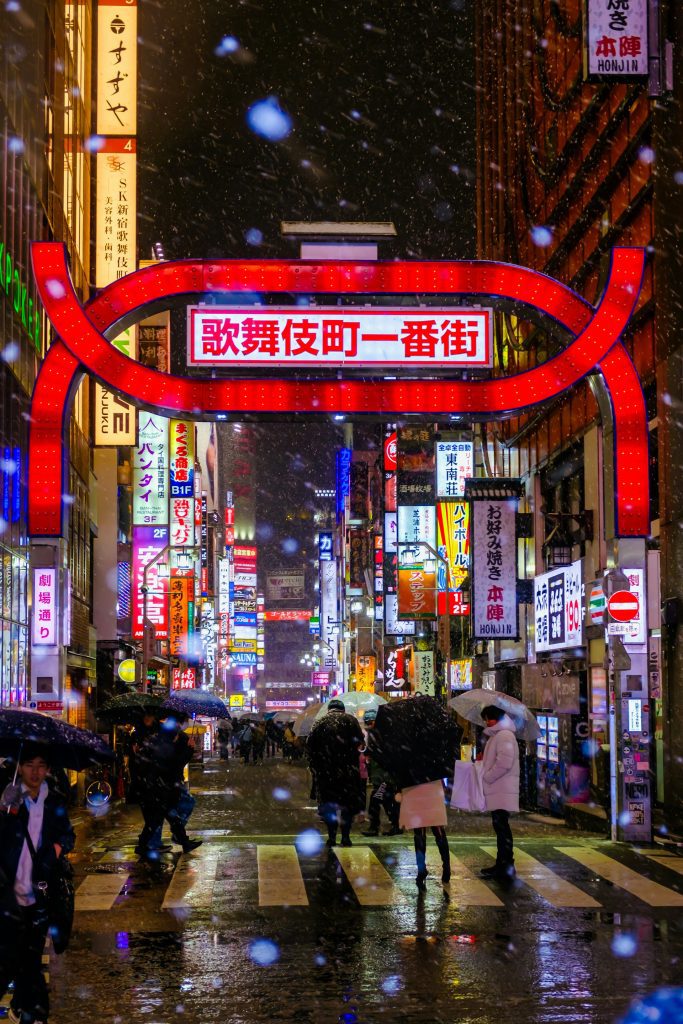
Just to the northeast of the station is Japan’s most famous entertainment area, easily recognized by its large neon signs and bustling activity at any hour.
Even though the district is named after a kabuki theatre that was never built, the area features countless restaurants (normally open 11:00-24:00), bars (open from evening to morning), nightclubs, pachinko halls, and love hotels. It is home to Robot Restaurant with its flashy performances, Toho Cinema with its landmark Godzilla head, and the Samurai Museum.
There are many restaurants in Kabukicho offering specialty cuisines from throughout Japan and abroad at budget izakaya prices to a high-end dining experience.
The district is generally safe but totally transforms from day to night, with most places staying open until sunrise. They close on Sundays when the visitors tend to drop in number.
Golden Gai
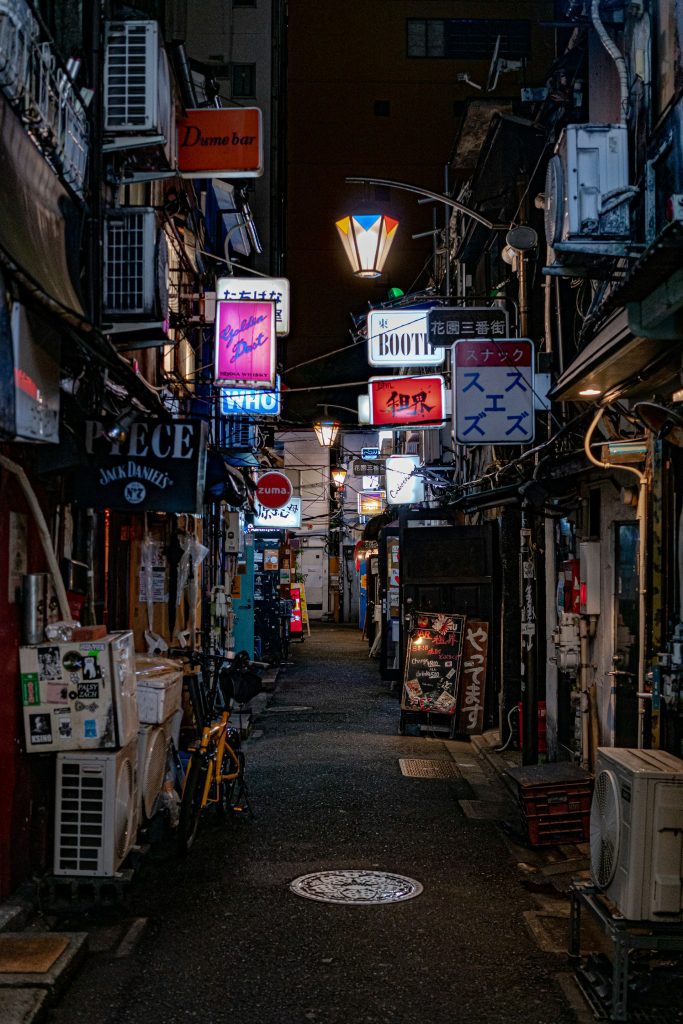
Golden Gai is a small atmospheric district within Kabukicho containing over 200 small restaurants and bars packed into six narrow streets connected by even narrower lanes.
Dating back to the post-war years, Golden Gai managed to escape rebuilding with much of Tokyo, preserving its own unique architectural heritage with two-story wood buildings. Most of the bars are very compact, holding as few as 5-10 customers, and every bar has its own theme – from jazz and whisky aficionados to movie memorabilia and old record collections.
The bars are usually run and owned by actors, writers, directors, and musicians, which has given the area a bohemian reputation. Bars tend to open around 19:00 or 20:00 and close at 5:00 in the morning and are completely closed on Sundays.
While in the past such bars catered to locals, some now actively court foreign visitors with English signs and menus. Cover charges are standard (about 500-1000 yen) and drinks cost about 700-1000 yen.
Omoide Yokocho
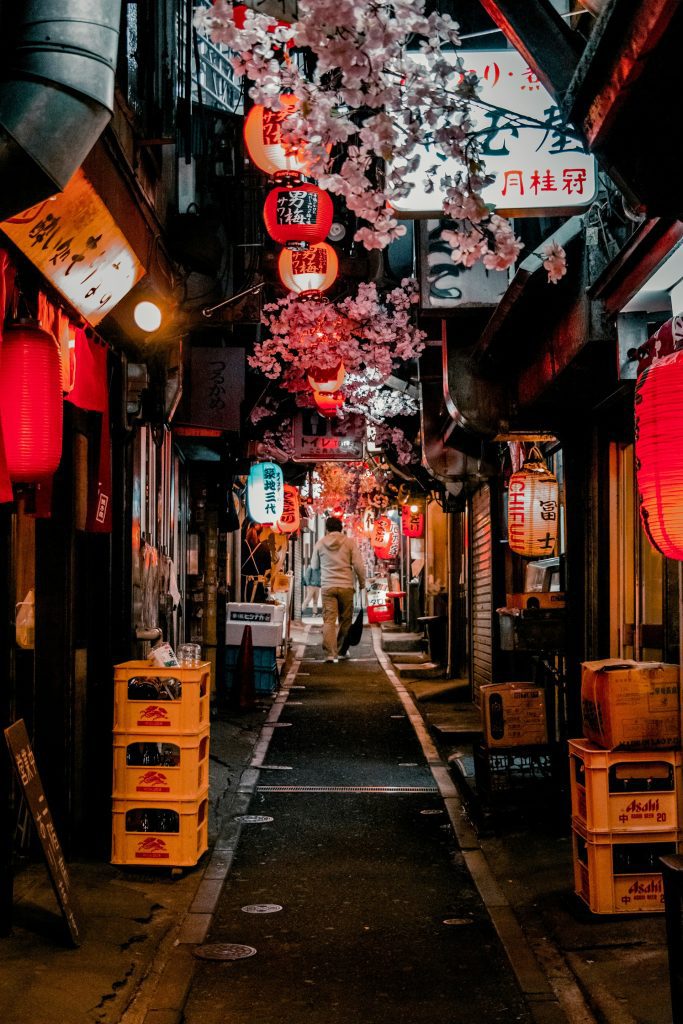
Omoide Yokocho, also known as “Memory Lane” or as the locals call it, “Piss Alley” (due to lack of facilities during the post-war days) is a network of narrow alleyways. The place is located northwest of Shinjuku Station,housing dozens of small eateries, preserved from the post–war era.
The alleys are so narrow that it can barely fit 2 people walking side-by-side but somehow manages to contain around 60 eateries. The eateries are famous for their yakitori (grilled chicken skewers), authentic ramens, fresh soba noodles, sushi counters, and retro bars.
Most restaurants operate from 17:00 to 24:00, though some open for lunch. Prices are typically lower than mainstream restaurants, with meals ranging from 800-2000 yen.
Shin-Okubo Koreatown
Located around Shin-Okubo Station (one stop north of Shinjuku), this area features Korean shops and restaurants operated by Korean residents. You’ll find K-Pop merchandise, videos, groceries, and authentic Korean cuisine.
Major Attractions
Tokyo Metropolitan Government Office
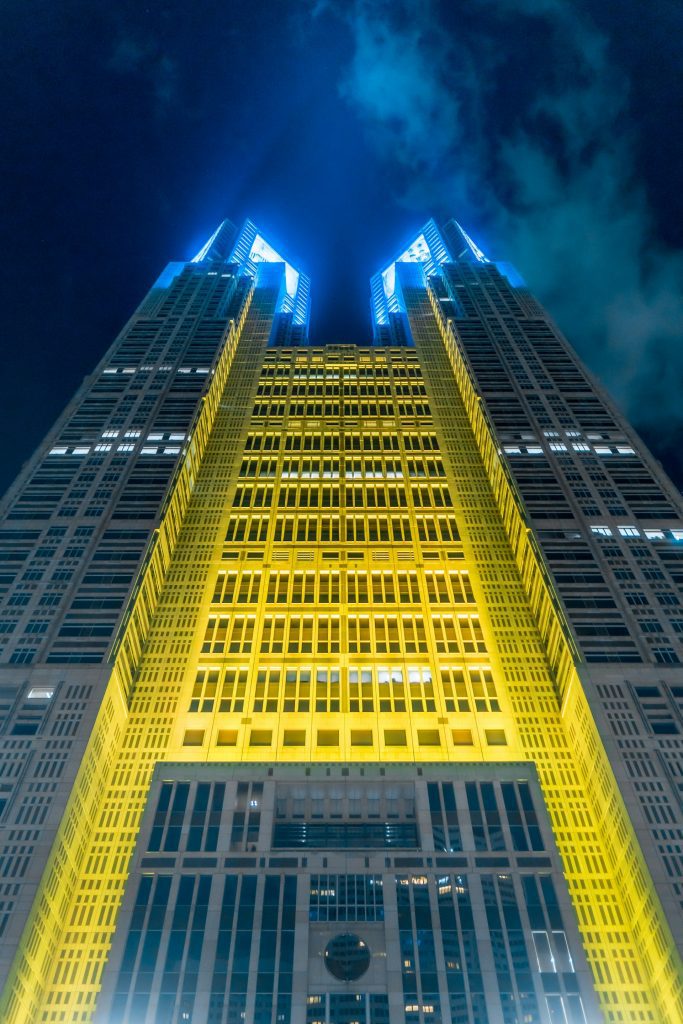
One of the major attractions of Shinjuku. This 243 meter tall twin tower was designed by famous architect, Kenzo Tange. The building serves as the administrative center for the Tokyo Metropolitan Government, housing the offices of the Governor, administrative head offices, and assembly hall.
Security check required upon entry but typically moves quickly. The tower has a public observatory deck on the 45th floor offering a panoramic view of the city. You can view the Tokyo Dome, Tokyo Sky-tree, and mountains including Mt. Fuji on clear days from the North observatory.
Whereas, from the south, you can overlook Yoyogi Park, Meiji Shrine, Tokyo Tower and Tokyo Bay. Both observatories contain souvenir shops and cafes.
- Visiting Hours: 9:30 to 22:00 (entry until 21:30)
- Closed: December 29 to January 3 (except January 1) and occasional inspection days
- Admission: Free
Shinjuku Gyoen
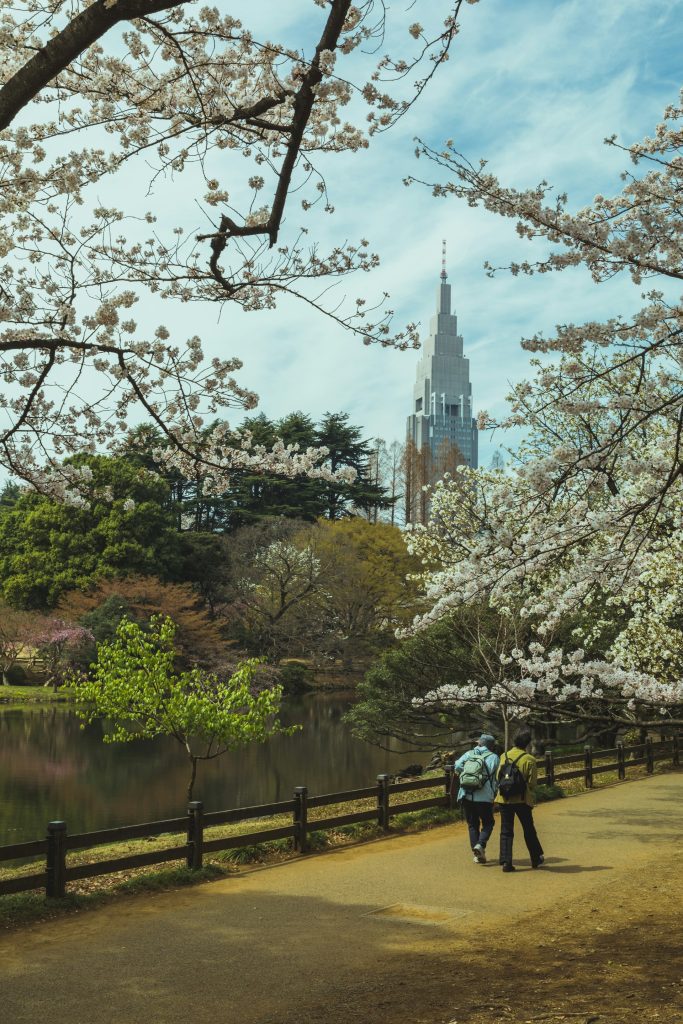
Shinjuku Gyoen National Garden is one of Tokyo’s largest parks, spanning 144 acres with 10,000 trees. The park is known for its cherry blossom viewing which includes 1,500 cherry trees that bloom from late March to April. The park opened to the public in 1949.
You can enter the park through Shinjuku, Okido, Sendagaya, or Yoyogi gates. Note that alcohol, sports activities, and music are prohibited.
- Visiting Hours: 9:00 to 18:00 (16:30 in winter, 19:00 in summer)
- Closed: Mondays (or next day if Monday is a holiday), and December 29 to January 3
- No closures during late March to late April and first half of November
- Admission: 500 yen
Shinjuku Central Park
Shinjuku Central Park sits in the heart of Tokyo’s business district, offering a refreshing urban retreat between skyscrapers. Located directly behind the Tokyo Metropolitan Government Building, this 9-acre park features open lawns, a children’s playground, and exercise equipment for public use. Unlike Shinjuku Gyoen, this park allows picnics and sports activities. It’s particularly popular with office workers during lunch hours and families on weekends.
- Visiting Hours: Always open
- Admission: Free
- Tips: Public park behind the Tokyo Metropolitan Government towers, home to Kumano Shrine
Shopping Destinations
Isetan
Isetan is a luxury department store in Shinjuku with over 130 years of history. The store represents the prestigious Isetan-Mitsukoshi group.Isetan is famous for its bespoke luxury brands and exceptional customer service.The legendary Depachika food hall on B2F houses over 200 specialty food vendors offering everything from traditional Japanese sweets to international cuisines. The store regularly hosts cultural exhibitions and seasonal events on its top floor, making it more than just a shopping destination but a cultural hub in Tokyo.
- Visiting Hours: 10:00 to 20:00 (restaurants typically 11:00 to 22:00)
- Direct access from Shinjuku-Sanchome Station
Takashimaya
Takashimaya in Shinjuku dates back to 1831 and masterfully blends traditional Japanese aesthetics with modern retail experiences. This luxury department store houses exclusive designer boutiques alongside traditional crafts and an extensive kimono selection that showcases Japan’s textile heritage. Art enthusiasts appreciate its renowned gallery hosting rotating exhibitions throughout the year. Foreign visitors benefit from special concierge and personal shopping services, including tax-free procedures and language assistance.
- Visiting Hours: 10:30 to 19:30 (restaurants 11:00 to 23:00)
- Tips: 15-floor department store within the “Takashimaya Times Square” complex, includes a Kinokuniya bookstore with foreign language section
- Closed January 1st and during periodic inventory days
- Rooftop garden offers city views and seasonal flower displays
Keio
Keio Department Store stands connected to Shinjuku Station’s west exit and functions as part of the larger Keio Group that operates major railway lines in western Tokyo. More affordable than luxury competitors, it caters to everyday shoppers with comprehensive selections of housewares, electronics, clothing, and daily necessities. The “Keio Food Market” in the basement level draws locals for quality groceries and prepared foods, making it a glimpse into authentic Tokyo shopping habits.
- Visiting Hours: 10:00 to 20:00 (restaurants 11:00 to 22:00)
- Closed during New Year’s holidays and for occasional inventory
- Tips: 11-floor department store scheduled for redevelopment
- Directly connected to Keio Line and JR Shinjuku Station
Lumine
Lumine operates multiple connected buildings around Shinjuku Station (Lumine 1, 2, and EST), targeting fashion-conscious shoppers in their 20s and 30s with over 800 stores collectively. Lumine EST particularly specializes in cutting-edge youth fashion and experimental Japanese designers not found elsewhere. The mall frequently hosts pop-up shops featuring limited-edition collaborations and new brand launches, while its extensive beauty floor showcases both international and Japanese cosmetic brands that beauty enthusiasts seek out.
- Visiting Hours: 11:00 to 21:00 (restaurants 11:00 to 22:00)
- The shopping complex is divided into “Lumine 1,” “Lumine 2,” and “Lumine Est” around the station’s South and East exits
- Closed January 1st and during annual inspection days
- Connected directly to JR Shinjuku Station’s east exit
Electronics
Yodobashi Camera
Yodobashi Camera dominates Shinjuku’s west side as one of Japan’s largest electronics retailers, spanning multiple buildings with distinctive yellow and black signage. This electronics paradise covers everything from cameras (its original specialty) to computers, home appliances, gaming equipment, beauty gadgets, and even toys. Beyond just selling products, Yodobashi offers hands-on demo areas where you can test the latest tech before buying. Their famous point card system gives generous discounts (often 10% back in points), making it popular with locals and tourists alike. The Multimedia Kan building houses their impressive duty-free counter with multilingual staff to assist foreign shoppers with tax exemption procedures.
- Visiting Hours: 9:30 to 22:00
- The store specializing in camera equipment with main store near west exit
- Open year-round (including holidays)
- Located 5 minutes from Shinjuku Station West Exit
- Free Wi-Fi available throughout the store
Bic Camera
Bic Camera operates several locations throughout Shinjuku, with its main store situated directly across from the East Exit of JR Shinjuku Station. This multi-floor electronics giant combines competitive prices with an extensive selection of Japanese and international brands. Unlike its competitor Yodobashi, Bic Camera incorporates more lifestyle products alongside electronics, including a dedicated floor for liquor featuring premium Japanese whiskies and sake. Their Shinjuku East store connects directly to Uniqlo, creating a convenient shopping experience for visitors seeking both tech and fashion. The store is particularly known for its pharmaceutical section selling Japanese cosmetics, supplements and medications popular with tourists.
- Visiting Hours: 10:00 to 21:00
- The store has two locations – one in Odakyu Halc Building (west exit) and one near Isetan
- Closed on rare occasions for inventory (typically 1-2 days per year)
- Multiple locations around Shinjuku Station (East Exit main store, Bicqlo, and Shinjuku West)
- Tax-free counters on each floor with service in English, Chinese and Korean
Transportation
Reaching Shinjuku is straightforward from major Tokyo hubs:
- From Tokyo Station: JR Chuo Line (Rapid Service) – orange trains that depart every 2-5 minutes during daytime. Takes under 15 minutes, costs 210 yen. Look for platform signs marked “中央線快速” (Chuo Line Rapid).
- From Ueno Station: JR Yamanote Line (the green loop line) takes 25 minutes, costs 210 yen. Alternatively, take JR Yamanote or Keihin-Tohoku Line to Kanda Station (2 minutes), then transfer to JR Chuo Line to Shinjuku for a slightly faster trip.
- From Narita Airport: Direct N’EX (Narita Express) trains run hourly, taking 80 minutes and costing 3,270 yen. Budget alternative: Keisei Line to Nippori, then transfer to JR lines (about 1,500 yen total).
- From Haneda Airport: Take Tokyo Monorail to Hamamatsucho, then JR Yamanote Line to Shinjuku (45-50 minutes, 650 yen). Alternative: Keikyu Line to Shinagawa, then JR to Shinjuku.
Key Station Exits
- East Exit: Access to Kabukicho, Golden Gai, Robot Restaurant, and department stores like Isetan
- South Exit: Connects to Takashimaya, Tokyu Hands, Kinokuniya Bookstore, Southern Terrace restaurants
- West Exit: Leads to skyscraper district, Tokyo Metropolitan Government Building, Yodobashi Camera, major hotels
- New South Exit: Direct access to Busta Shinjuku (highway bus terminal)
- Southeast Exit: Shortest route to Shinjuku Gyoen gardens
The JR lines use prepaid Suica/Pasmo IC cards or paper tickets, while private subway lines in the station (Marunouchi, Toei Shinjuku, Toei Oedo, Seibu-Shinjuku) may require separate tickets if you don’t use an IC card.
FAQ
What is Shinjuku famous for?
Shinjuku is famous for being Tokyo’s largest entertainment district with its neon-lit Kabukicho area, massive shopping complexes, and the world’s busiest train station. It’s also known for its towering skyscrapers including the Tokyo Metropolitan Government Building, vibrant nightlife, and diverse dining options.
Which part of Shinjuku to avoid?
While generally safe, some areas of Kabukicho after midnight can feel intimidating due to touts aggressively promoting adult entertainment venues. Smaller alleyways in Golden Gai might be best avoided late at night if you’re traveling alone and unfamiliar with the area.
Is Shinjuku a city in Tokyo?
Shinjuku is not a separate city but one of Tokyo’s 23 special wards or administrative districts. It functions as one of Tokyo’s major commercial and administrative centers, housing the Tokyo Metropolitan Government headquarters.
What is the best area to stay in Tokyo?
Shinjuku offers excellent transportation connections and abundant nightlife, shopping, and dining options, making it ideal for first-time visitors. Alternatively, Tokyo Station/Ginza area provides convenient access to major attractions and luxury shopping with a more upscale atmosphere.
Is it safe to walk in Shinjuku?
Shinjuku is extremely safe to walk around, even at night, with well-lit streets and a constant police presence. Like anywhere in Tokyo, it maintains Japan’s reputation for safety, though standard precautions are always recommended in crowded areas.
Do people speak English in Shinjuku?
Major stores, hotels, and restaurants in Shinjuku typically have staff with basic English skills and English menus available. However, in smaller establishments and with older residents, English proficiency is limited, so having a translation app ready is helpful.
Is Shinjuku better at night or day?
Shinjuku offers completely different experiences between day and night—daytime reveals excellent shopping and peaceful gardens, while nighttime transforms it with neon lights and vibrant entertainment. Ideally, experience both to see the district’s dramatic transformation from business hub to entertainment wonderland.
Why is Shinjuku so popular?
Shinjuku’s popularity stems from its perfect blend of convenience, entertainment options, and urban excitement in one compact area. Its status as a major transportation hub connecting to everywhere in Tokyo, combined with world-class shopping, dining, and nightlife makes it a microcosm of modern Tokyo life.
What time to visit Shinjuku?
The best time to visit Shinjuku is between 3PM-10PM to experience both daytime shopping and the transition to its famous nighttime atmosphere. Weekday afternoons tend to be less crowded than weekends, though visiting after 7PM on Friday or Saturday gives you the full electric nightlife experience.



